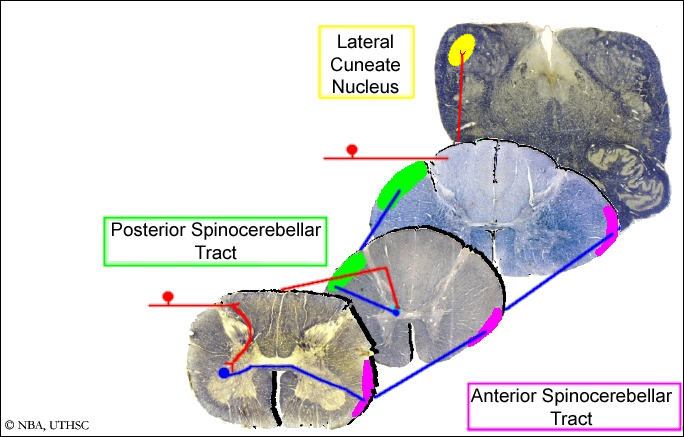Lab 3 (ƒ5) - Somatosensory, Viscerosensory and Spinocerebellar Pathways
Spinocerebellar Pathways - Overview
Spinocerebellar and cuneocerebellar tracts: Mechanoreceptive afferents from the lower extremity ascend through fasciculus gracilis (FG) to reach Clark’s nucleus, whose cells give rise to the ipsilateral posterior spinocerebellar tract (PSCT), which enters the inferior cerebellar peduncle and ends ipsilaterally in the vermis of the anterior lobe.
 A larger variety of afferents end on other cells of the spinal gray matter, whose axons form the contralateral anterior spinocerebellar tract (ASCT); this tract ascend to the pons, loops over the superior cerebellar peduncle, and re-crosses in the vermis of the anterior lobe. Mechanoreceptive afferents from the upper extremity ascend to the medulla in the fasciculus cuneatus (FC) and end in the lateral cuneate nucleus (analogous to Clark’s nucleus). These lateral cuneate nuclear cells give rise to the cuneocerebellar tract (CCT), which enters the inferior cerebellar peduncle and ends ipsilaterally in the vermis of the anterior lobe. The rostral spinocerebellar tract is not shown in this diagram.
A larger variety of afferents end on other cells of the spinal gray matter, whose axons form the contralateral anterior spinocerebellar tract (ASCT); this tract ascend to the pons, loops over the superior cerebellar peduncle, and re-crosses in the vermis of the anterior lobe. Mechanoreceptive afferents from the upper extremity ascend to the medulla in the fasciculus cuneatus (FC) and end in the lateral cuneate nucleus (analogous to Clark’s nucleus). These lateral cuneate nuclear cells give rise to the cuneocerebellar tract (CCT), which enters the inferior cerebellar peduncle and ends ipsilaterally in the vermis of the anterior lobe. The rostral spinocerebellar tract is not shown in this diagram.
